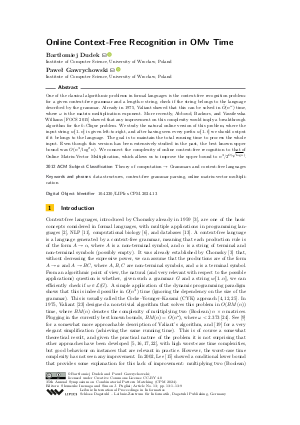Online Context-Free Recognition in OMv Time
Authors
Bartłomiej Dudek  ,
Paweł Gawrychowski
,
Paweł Gawrychowski 
-
Part of:
Volume:
35th Annual Symposium on Combinatorial Pattern Matching (CPM 2024)
Part of: Series: Leibniz International Proceedings in Informatics (LIPIcs)
Part of: Conference: Annual Symposium on Combinatorial Pattern Matching (CPM) - License:
 Creative Commons Attribution 4.0 International license
Creative Commons Attribution 4.0 International license
- Publication Date: 2024-06-18
File

PDF
LIPIcs.CPM.2024.13.pdf
- Filesize: 0.81 MB
- 9 pages
Document Identifiers
Subject Classification
ACM Subject Classification
- Theory of computation → Grammars and context-free languages
Keywords
- data structures
- context-free grammar parsing
- online matrix-vector multiplication
Metrics
- Access Statistics
-
Total Accesses (updated on a weekly basis)
0PDF Downloads0Metadata Views
Abstract
One of the classical algorithmic problems in formal languages is the context-free recognition problem: for a given context-free grammar and a length-n string, check if the string belongs to the language described by the grammar. Already in 1975, Valiant showed that this can be solved in {O}̃(n^ω) time, where ω is the matrix multiplication exponent. More recently, Abboud, Backurs, and Vassilevska Williams [FOCS 2015] showed that any improvement on this complexity would imply a breakthrough algorithm for the k-Clique problem. We study the natural online version of this problem, where the input string w[1..n] is given left-to-right, and after having seen every prefix w[1..t] we should output if it belongs to the language. The goal is to maintain the total running time to process the whole input. Even though this version has been extensively studied in the past, the best known upper bound was {O}(n³/log²n). We connect the complexity of online context-free recognition to that of Online Matrix-Vector Multiplication, which allows us to improve the upper bound to n³/2^{Ω(√{log{n}})}.
Cite As Get BibTex
Bartłomiej Dudek and Paweł Gawrychowski. Online Context-Free Recognition in OMv Time. In 35th Annual Symposium on Combinatorial Pattern Matching (CPM 2024). Leibniz International Proceedings in Informatics (LIPIcs), Volume 296, pp. 13:1-13:9, Schloss Dagstuhl – Leibniz-Zentrum für Informatik (2024)
https://doi.org/10.4230/LIPIcs.CPM.2024.13
BibTex
@InProceedings{dudek_et_al:LIPIcs.CPM.2024.13,
author = {Dudek, Bart{\l}omiej and Gawrychowski, Pawe{\l}},
title = {{Online Context-Free Recognition in OMv Time}},
booktitle = {35th Annual Symposium on Combinatorial Pattern Matching (CPM 2024)},
pages = {13:1--13:9},
series = {Leibniz International Proceedings in Informatics (LIPIcs)},
ISBN = {978-3-95977-326-3},
ISSN = {1868-8969},
year = {2024},
volume = {296},
editor = {Inenaga, Shunsuke and Puglisi, Simon J.},
publisher = {Schloss Dagstuhl -- Leibniz-Zentrum f{\"u}r Informatik},
address = {Dagstuhl, Germany},
URL = {https://drops.dagstuhl.de/entities/document/10.4230/LIPIcs.CPM.2024.13},
URN = {urn:nbn:de:0030-drops-201235},
doi = {10.4230/LIPIcs.CPM.2024.13},
annote = {Keywords: data structures, context-free grammar parsing, online matrix-vector multiplication}
}
Author Details
References
-
Amir Abboud, Arturs Backurs, and Virginia Vassilevska Williams. If the current clique algorithms are optimal, so is Valiant’s parser. In FOCS, pages 98-117. IEEE Computer Society, 2015.

-
Alfred V. Aho, Ravi Sethi, and Jeffrey D. Ullman. Compilers: Principles, Techniques, and Tools. Addison-Wesley series in computer science / World student series edition. Addison-Wesley, 1986.

-
Noam Chomsky. On certain formal properties of grammars. Inf. Control., 2(2):137-167, 1959.

-
John Cocke and Jacob T. Schwartz. Programming languages and their compilers: Preliminary notes (technical report) (2nd revised ed. Technical report, CIMS, NYU, 1970.

-
Shay B. Cohen, Giorgio Satta, and Michael Collins. Approximate PCFG parsing using tensor decomposition. In HLT-NAACL, pages 487-496. The Association for Computational Linguistics, 2013.

-
Richard Durbin, Sean R. Eddy, Anders Krogh, and Graeme J. Mitchison. Biological Sequence Analysis: Probabilistic Models of Proteins and Nucleic Acids. Cambridge University Press, 1998.

-
Hervé Gallaire. Recognition time of context-free languages by on-line turing machines. Inf. Control., 15(3):288-295, 1969.

-
Susan L. Graham, Michael A. Harrison, and Walter L. Ruzzo. An improved context-free recognizer. ACM Trans. Program. Lang. Syst., 2(3):415-462, 1980.

-
M. A. Harrison. Introduction to Formal Language Theory. Addison-Wesley Longman Publishing Co., Inc., USA, 1st edition, 1978.

-
Monika Henzinger, Sebastian Krinninger, Danupon Nanongkai, and Thatchaphol Saranurak. Unifying and strengthening hardness for dynamic problems via the online matrix-vector multiplication conjecture. In STOC, pages 21-30. ACM, 2015.

-
Dan Jurafsky and James H. Martin. Speech and language processing: an introduction to natural language processing, computational linguistics, and speech recognition, 2nd Edition. Prentice Hall series in artificial intelligence. Prentice Hall, Pearson Education International, 2009.

-
Tadao Kasami. An efficient recognition and syntax algorithm for context-free language. Technical Report AFCRL-65-758, Air Force Cambridge Research Lab, Bed-ford, MA., 1965.

-
Flip Korn, Barna Saha, Divesh Srivastava, and Shanshan Ying. On repairing structural problems in semi-structured data. Proc. VLDB Endow., 6(9):601-612, 2013.

-
Kasper Green Larsen and R. Ryan Williams. Faster online matrix-vector multiplication. In SODA, pages 2182-2189. SIAM, 2017.

-
Lillian Lee. Fast context-free grammar parsing requires fast boolean matrix multiplication. J. ACM, 49(1):1-15, 2002.

-
Adam Pauls and Dan Klein. K-best A* parsing. In ACL/IJCNLP, pages 958-966. The Association for Computer Linguistics, 2009.

-
Alexander M. Rush, David A. Sontag, Michael Collins, and Tommi S. Jaakkola. On dual decomposition and linear programming relaxations for natural language processing. In EMNLP, pages 1-11. ACL, 2010.

-
Wojciech Rytter. Fast recognition of pushdown automaton and context-free languages. Information and Control, 67(1-3):12-22, 1985.

-
Wojciech Rytter. Context-free recognition via shortest paths computation: A version of Valiant’s algorithm. Theor. Comput. Sci., 143(2):343-352, 1995.

-
Joel I. Seiferas. A simplified lower bound for context-free-language recognition. Inf. Control., 69(1-3):255-260, 1986.

-
Michael Sipser. Introduction to the theory of computation. PWS Publishing Company, 1997.

-
Richard Socher, John Bauer, Christopher D. Manning, and Andrew Y. Ng. Parsing with compositional vector grammars. In ACL (1), pages 455-465. The Association for Computer Linguistics, 2013.

-
Leslie G. Valiant. General context-free recognition in less than cubic time. J. Comput. Syst. Sci., 10(2):308-315, 1975.

-
Virginia Vassilevska Williams, Yinzhan Xu, Zixuan Xu, and Renfei Zhou. New bounds for matrix multiplication: from alpha to omega. In SODA, pages 3792-3835. SIAM, 2024.

-
Daniel H. Younger. Recognition and parsing of context-free languages in time n³. Inf. Control., 10(2):189-208, 1967.

